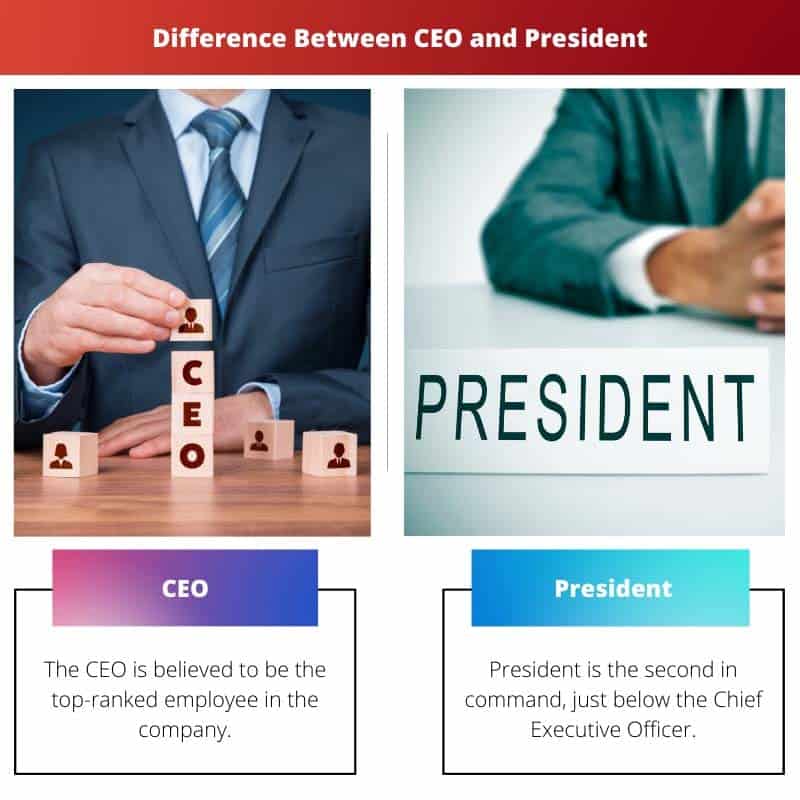In basic terms, the CEO pledges the business, laying out a long-term strategy for the company’s future. The firm’s president honours his word and runs the organization in a way that makes his project a success.
Key Takeaways
- The CEO is responsible for a company’s overall strategic direction and management, while the President is responsible for day-to-day operations.
- The CEO is the highest-ranking executive in a company, while the President may be subordinate to the CEO or maybe in a separate position with its responsibilities.
- The CEO is responsible for making major decisions about the company’s vision, strategy, and long-term goals. At the same time, the President is focused on executing those decisions and managing the company’s day-to-day operations.
CEO vs President
CEO means Chief Executive Officer and is the top ranking employee of a company that manages the executive team and is responsible for the growth of the company. President is the second-in-command of a company or organization, but in some cases, this position is occupied by the CEO.

CEOs are responsible for managing a business’s functions and operations, making significant strategic choices, acting as the main interface between the management board and business operations, and acting as the public face of the corporation, among other things.
It’s not uncommon for a company’s CEO to be the president. If a person is talking about somebody in charge of a section or a key area inside an organization, you’re talking about someone who is in charge.
Comparison Table
| Parameters of Comparison | CEO | President |
|---|---|---|
| Rankings | The CEO is believed to be the top-ranked employee in the company. | President is the second in command, just below the Chief Executive Officer. |
| Role | CEOs make a pledge to the organization and create a vision for the future. | Execution and honoring promises are key to bringing the vision to fruition for the President. |
| Key Tasks | The CEO needs to ensure the management has all the knowledge, and they analyze the surroundings for growth chances. It’s their job to set budgets, steer the organization in the proper direction and cultivate a positive work environment, as well as to lead a team of people. | Implementing targets, marketing campaigns, overseeing sales, and doing research and innovation are the main duties of the president. A number of other important activities may include optimizing processes, designing and implementing frameworks, and planning for the future of the company. |
| Measurement of Success | Innovating gives a business a competitive position in the industry, and that is how a CEO’s performance is judged. Metrics such as earnings per share, return on capital, increased revenues, and continuous working capital growth can be used to evaluate CEOs’ performances. | It is the President’s job to take over from the CEO. As a result, the President’s effectiveness has a direct bearing on his or her connection with the CEO. |
| Seat in the Board | A CEO has a strong foothold on the board of directors. | Whereas, depending on the board, the president might not have a position. |
What is CEO?
They are responsible for managing a business’s functions and operations, making significant strategic choices, acting as the main interface between the management board and business operations, and acting as the public face of the corporation, among other things.
It’s common for a CEO to serve on a supervisory board, and they’re in control of executive activities, while the CEO is in control of combining business policy with everyday activities.
Some conglomerates have one chief executive who supervises a multitude of presidents, each of whom is in charge of a distinct business and reports to the very same chief executive officer.

What is President?
It’s not uncommon for a company’s CEO to be the president. In certain cases, the president also serves as the CEO of the company.
If the organization is young, the president may also be the proprietor. For example, if a CEO has already taken responsibility for a corporation or organization, the president is the person who is part of the management team.
As a general rule, the board of trustees creates policy, the presidency implements strategy and comes back to the group, and finally, the panel reflects directly to the shareholders, who are ultimately the owners.

Main Differences Between CEO and President
- Innovating gives a business a competitive position in the industry, and that is how a CEO’s performance is judged. Metrics such as earnings per share, return on capital, increased revenues, and continuous working capital growth can be used to evaluate CEOs’ performances.
- A CEO has a strong foothold on the board of directors. Whereas, depending on the board, the president might not have a position.






